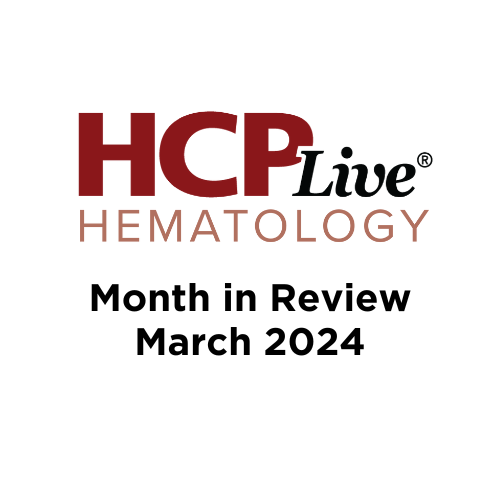Hematology Month in Review: March 2024
Our March 2024 month-in-review in hematology features updates to the anemia pipeline, the latest research in sickle cell disease, and the role of SGLT2 inhibition on hematologic outcomes.
Credit: HCPLive

Our coverage of hematology last month was packed as we set out to uncover the latest in the study of blood and blood disorders, from updates in treatment of anemia and sickle cell disease (SCD), to crossover interest from other branches of medicine.
In our March 2024 hematology month-in-review, we spotlight the latest US Food and Drug Administration (FDA) approvals and phase 3 data, the range of severity in comorbidities faced by children and adults with sickle cell disease (SCD), as well as the role of opioid guidelines on SCD-related crises, and crossover interest in the interplay between iron deficiency and cardiometabolic diseases.
Pipeline News
FDA Approves Vadadustat (Vafseo) Tablets for Anemia Due to CKD in Adult Patients on Dialysis
On March 27, 2024, the FDA approved vadadustat (Vafseo) for treating anemia due to chronic kidney disease (CKD) in adult patients on dialysis. Announced by Akebia Therapeutics, approval was awarded based on efficacy and safety data from the INNO2VATE program and assessment of post-marketing safety data from Japan, where the drug was launched in August 2020.
The approval comes nearly two years after the oral hypoxia-inducible factor prolyl hydroxylase (HIF-PH) inhibitor was issued a Complete Response Letter (CRL) due to a lack of favorable risk-benefit assessment in dialysis and non-dialysis patients, with notable concern over the agent’s failure to meet noninferiority to darbepoetin alfa in major adverse cardiovascular events (MACE).
Iptacopan Promotes Anemia Resolution in Paroxysmal Nocturnal Hemoglobinuria
Oral iptacopan monotherapy was linked to clinically meaningful improvement in hemoglobin levels in patients with paroxysmal nocturnal hemoglobinuria (PNH), with persistent anemia.
A first-in-class oral factor B inhibitor, iptacopan was assessed in the phase 3 APPLY-PNH and APPOINT-PNH trials, over a 24-week core treatment period and a 24-week extension. Across both trials, approximately two-thirds of patients reached normal or near-normal hemoglobin levels, demonstrating the potential benefit of proximal complement inhibition in resolving anemia in PNH.
Sickle Cell Disease
CDC Opioid Guidelines Linked to Negative Consequences in Sickle Cell Disease
Release of the 2016 Centers for Disease Control and Prevention (CDC) guidelines were linked to unintended, negative consequences for patients with SCD. Intended to promote safer and more effective use of prescription opioids in populations outside of SCD, limitations in pain treatment were recognized for patients with SCD, including a decrease in opioid prescriptions and an increase in pain-related healthcare utilization.
“Decreases in prescription opinions among those with SCD imply that this population was susceptible to the guideline’s recommendations and subsequent changes in regulations by state legislatures and health insurance organizations,” wrote Hyeun Ah Kang, PhD, and colleagues at The University of Texas at Austin.
Children with Sickle Cell Disease Experience Severe COVID-19 Infection
Children with SCD are at risk of severe disease with SARS-CoV-2 infection, according to analysis of the Pediatric COVID-19 United States Registry. Approximately one-third of children with SCD required hospitalization with COVID-19 infection, with nearly half of these hospitalizations requiring supplemental oxygen.
“Our results indicate that a higher proportion of hospitalized children with SCD and COVID-19 had severe infection requiring supplemental oxygen, compared to the general population, a finding that has been showing in other viral illnesses, particularly influenza,” wrote Aleksandra S. Dain, MD and colleagues at the Children’s Hospital of Philadelphia.
Presence of CKD in Sickle Cell Disease Worsens In-Hospital Outcomes
Chronic kidney disease (CKD) is a prevalent complication in SCD and its presence was linked to a rise in mortality after hospitalization and increased hospital charges, according to an assessment of the National Inpatient Sample (NIS). Data from the NIS showed those with CKD and SCD were more likely to need mechanical ventilation, blood transfusion, and develop sepsis, but less likely to experience in-hospital acute chest syndrome and pulmonary embolism, versus the non-CKD population.
Cross-Specialty Interest
Intravenous Iron Increases Hemoglobin in Heart Failure Treated with SGLT2 Inhibition
Post-hoc exploratory analysis of the IRONMAN trial identified an increasing trend in hemoglobin levels with intravenous ferric derisomaltose treatment among iron-deficient patients with heart failure taking a sodium-glucose co-transporter 2 (SGLT2) inhibitor at baseline.
“To our knowledge, these are the first randomized trial data providing insights into the treatment of iron deficiency with intravenous iron in patients with heart failure with reduced ejection fraction (HFrEF) taking an SGLT2 inhibitor, although any conclusions are limited by the small number of patients taking an SGLT2 inhibitor at baseline,” wrote Kieran F. Docherty, PhD, of the BHF Cardiovascular Research Center at the University of Glasgow.
SGLT2 Inhibitor Use Lowers Anemia Risk in Patients with Diabetes, CKD
SGLT2 inhibition may reduce the risk of anemia among patients with type 2 diabetes (T2D) and CKD stages 1 to 3, according to an analysis of approximately 14,000 patients with both conditions. Initiation of an SGLT2 inhibitor was linked to a 19% decrease in incident anemia risk compared with treatment with glucagon-like peptide-1 receptor agonists (GLP-1 RA).
“These main findings were supported by changes in hematological laboratory parameters, which showed significant differences between the SGLT2 inhibitor and GLP-1 RA groups throughout the 3-year follow-up,” investigators wrote, led by Shih-Chieh Shao, RPh, PhD, department of pharmacy, Keelung Chang Gung Memorial Hospital.